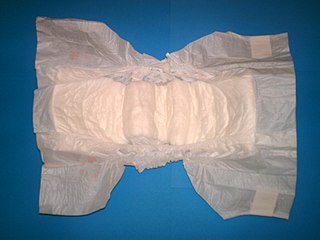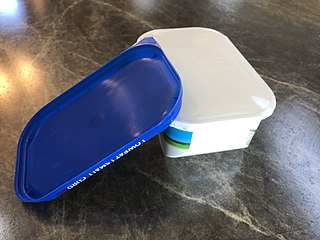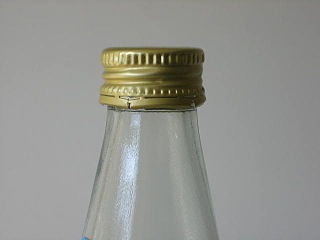
A diaper or a nappy is a type of underwear that allows the wearer to urinate or defecate without using a toilet, by absorbing or containing waste products to prevent soiling of outer clothing or the external environment. When diapers become wet or soiled, they require changing, generally by a second person such as a parent or caregiver. Failure to change a diaper on a sufficiently regular basis can result in skin problems around the area covered by the diaper.

A drum is a cylindrical shipping container used for shipping bulk cargo. Drums can be made of steel, dense paperboard, or plastic, and are generally used for the transportation and storage of liquids and powders. Drums are often stackable, and have dimensions designed for efficient warehouse and logistics use. This type of packaging is frequently certified for transporting dangerous goods. Proper shipment requires the drum to comply with all applicable regulations.

A stopper, bung, or cork is a cylindrical or conical closure used to seal a container, such as a bottle, tube, or barrel.

A closure is a device used to close or seal a container such as a bottle, jug, jar, tube, or can. A closure may be a cap, cover, lid, plug, liner, or the like. The part of the container to which the closure is applied is called the finish.
Tamper-evident describes a device or process that makes unauthorized access to the protected object easily detected. Seals, markings, or other techniques may be tamper indicating.

A heat sealer is a machine used to seal products, packaging, and other thermoplastic materials using heat. This can be with uniform thermoplastic monolayers or with materials having several layers, at least one being thermoplastic. Heat sealing can join two similar materials together or can join dissimilar materials, one of which has a thermoplastic layer.

Playtex is an American brand name for undergarments, baby products, gloves, feminine hygiene products, and sunscreen. The brand began in 1947 when International Latex Corporation (ILC) created a division named Playtex to produce and sell latex products. Playtex was the first to advertise undergarments on national television in 1955, written by Howard Shavelson at Ogilvy and Mather, and the first to show a woman wearing only a bra from the waist up in a commercial in 1977. They developed space suits for the Apollo program.

A lid or cover is part of a container, and serves as the closure or seal, usually one that completely closes the object. Lids can be placed on small containers such as tubs as well as larger lids for open-head pails and drums. Some lids have a security strip or a tamper-evident band to hold the lid on securely until opening is desired or authorized. These are usually irreversible to indicate that the container has been opened. They can be made of varying materials ranging from plastic to metal.

A blister pack is any of several types of pre-formed plastic packaging used for small consumer goods, foods, and for pharmaceuticals.

Bear-resistant food storage containers, also called bear canisters or bear cans, are usually hard-sided containers used by backpackers to protect their food from theft by bears. Bear canisters are seeing increased popularity in areas where bears have become habituated to human presence, and are required in some places, such as Yosemite National Park in the United States.

A widget is a device placed in a container of beer to manage the characteristics of the beer's head. The original widget was patented in Ireland by Guinness. The "floating widget" is found in cans of beer as a hollow plastic sphere, approximately 3 centimetres (1.2 in) in diameter with two small holes and a seam. The "rocket widget" is found in bottles, 7 centimetres (2.8 in) in length with the small hole at the bottom.

Rubber pants or rubber panties were the predecessor to plastic pants and served the purpose of a diaper cover, replacing the woolen garment. However, "rubber pants" is still a generic term for any pull-on or snap-on incontinence protective garment.

Induction sealing is the process of bonding thermoplastic materials by induction heating. This involves controlled heating an electrically conducting object by electromagnetic induction, through heat generated in the object by eddy currents.

Vacuum packing is a method of packaging that removes air from the package prior to sealing. This method involves placing items in a plastic film package, removing air from inside and sealing the package. Shrink film is sometimes used to have a tight fit to the contents. The intent of vacuum packing is usually to remove oxygen from the container to extend the shelf life of foods and, with flexible package forms, to reduce the volume of the contents and package.
Aseptic processing is a processing technique wherein commercially thermally sterilized liquid products are packaged into previously sterilized containers under sterile conditions to produce shelf-stable products that do not need refrigeration. Aseptic processing has almost completely replaced in-container sterilization of liquid foods, including milk, fruit juices and concentrates, cream, yogurt, salad dressing, liquid egg, and ice cream mix. There has been an increasing popularity for foods that contain small discrete particles, such as cottage cheese, baby foods, tomato products, fruit and vegetables, soups, and rice desserts.
Baby Magic is an American brand of baby care products marketed by Naterra in the United States. The brand has traditionally included baby-care items such as baby shampoo, baby lotion, baby soaps, and diaper wipes. In Mexico and Latin America, the brand is marketed by Colgate-Palmolive as Baby Magic Mennen, and includes the similar items. The product design and manufacturing origin vary by country.

A tamper-evident band or security ring serves as a tamper resistant or tamper evident function to a screw cap, lid, or closure. The term tamper-proof is sometimes used but is considered a misnomer given that pilfering is still technically possible.

Drug packaging is process of packing pharmaceutical preparations for distribution, and the physical packaging in which they are stored. It involves all of the operations from production through drug distribution channels to the end consumer.

Resealable packaging is any type of packaging that allows the consumer or user to reseal or reclose the packaging. Often packaging needs to be resealed in order to maintain product freshness or prevent spillage. Reusable packaging allows for multiple uses which can help reduce waste.

In technical usage in the shipping industry, a pail is a type of cylindrical shipping container with a capacity of about 3 to 50 litres. It can have straight or slanted sides and usually has a handle or bail. In non-technical usage, a pail is synonymous with a bucket.

















